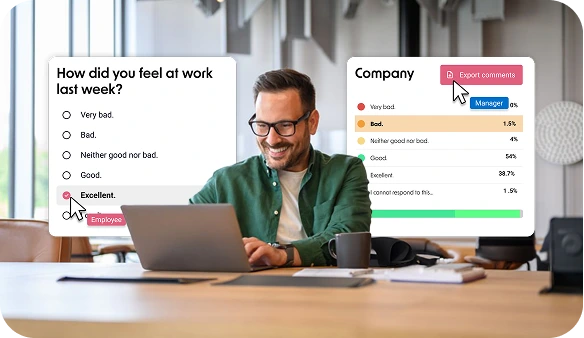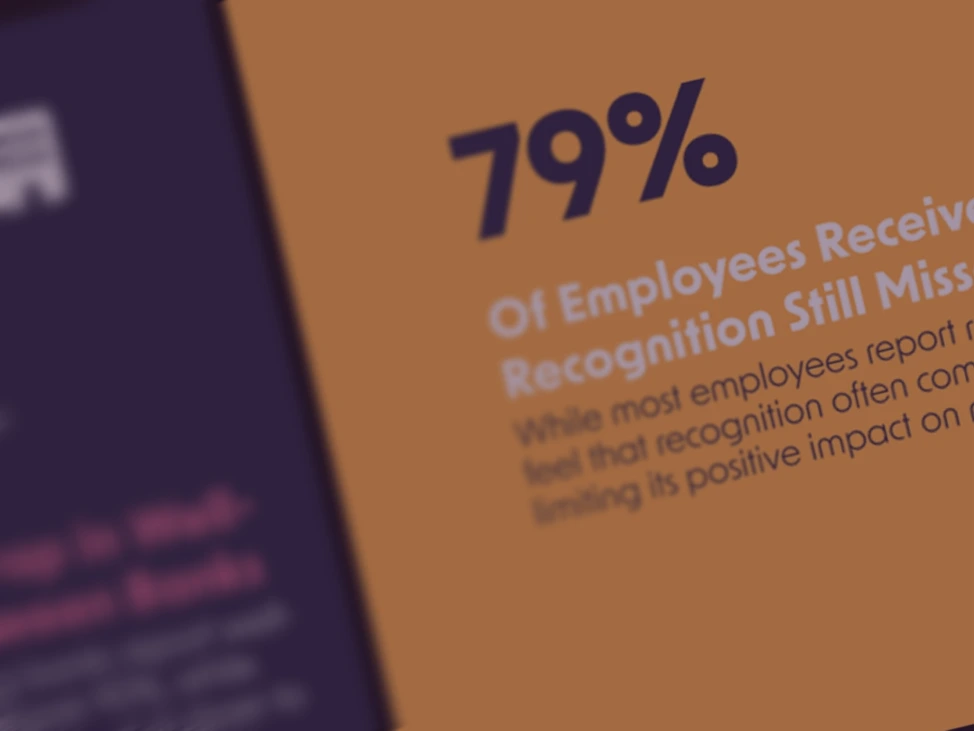12 Types of Employees and How to Engage Each One in 2025

Understanding the different types of employees in your organisation is key to building a high-performing, resilient workplace. While job titles and roles tell you what someone does, behavioural patterns reveal how they work—and what they need to stay engaged.
At HeartCount, we help organisations move beyond one-size-fits-all strategies by giving leaders real-time insights into what’s really driving their teams. And it matters more than ever: a recent Gallup study found that only 21% of employees globally feel engaged at work—a clear signal that personalised leadership is no longer optional.
This guide breaks down 12 distinct employee types and shows you how to support each one using data, empathy, and smart engagement tactics.
-
1.Why Knowing the Different Types of Employees Boosts Engagement & Retention
-
2.The 12 Engagement Archetypes (Traits, Early-Warning Signs & Tactics)
-
3.From Insight to Action: HeartCount’s Listen → Diagnose → Act Framework
-
4.Quick Reference: Common HR Classifications of Employees
-
5.FAQ: Different Types of Employees Explained
Understanding the different types of employees in your organisation is key to building a high-performing, resilient workplace. While job titles and roles tell you what someone does, behavioural patterns reveal how they work—and what they need to stay engaged.
At HeartCount, we help organisations move beyond one-size-fits-all strategies by giving leaders real-time insights into what’s really driving their teams. And it matters more than ever: a recent Gallup study found that only 21% of employees globally feel engaged at work—a clear signal that personalised leadership is no longer optional.
This guide breaks down 12 distinct employee types and shows you how to support each one using data, empathy, and smart engagement tactics.
Why Knowing the Different Types of Employees Boosts Engagement & Retention
Not all employees are motivated the same way—and that matters more than ever in 2025. As hybrid work models, shifting expectations, and generational dynamics reshape workplaces, understanding the different types of employees isn’t just an HR nicety—it’s a retention strategy.
Managers often focus on averages: the average satisfaction score, the average output, the average team sentiment. But within every team, there’s a wide range of engagement drivers, blockers, and behavioural patterns. Recognising these variations early helps organisations intervene with targeted support before issues snowball into burnout, disengagement, or turnover.
HeartCount’s employee overview section
With tools like HeartCount’s Employee Overview, teams can move from reactive to proactive by spotting patterns in real-time—whether it’s a drop in recognition scores for your Quiet Contributor or rising workload strain on your High Performer. The goal isn’t to label people, but to personalise how we support them.
By understanding employee archetypes, organisations can:
- Reduce avoidable attrition
- Tailor leadership styles to individual needs
- Make smarter, faster engagement decisions based on pulse data
Want to go deeper into the drivers behind workplace motivation? Explore our guide on how to drive employee engagement.
Pulse-Survey Data: Engagement Gaps by Employee Type
Pulse surveys are more than just check-ins—they’re diagnostic tools. And when analysed through the lens of employee types, they reveal critical engagement gaps that generic reports often miss.
For example, your Challenger might consistently rate low on alignment, while a Harmonizer shows high satisfaction but avoids conflict-related questions. Meanwhile, an Under-Resourced employee may show sudden drops in energy or wellbeing indicators—not because they’re disengaged, but because they’re overwhelmed.
HeartCount’s employee check survey
By slicing pulse data across engagement archetypes, HR and team leads can:
- Detect early-warning flags before burnout or resignation hits
- Customise conversations based on behavioural context
- Track change-readiness across roles and personality types
Instead of asking “Is this team engaged?”, start asking: “Which types within this team are quietly struggling?” That’s where the real insight lives—and where action can begin.
Cost of Ignoring Diverse Motivation Profiles
Treating everyone the same may seem fair—but when it comes to employee engagement, it’s ineffective. Overlooking the nuanced motivations behind different types of employees leads to misalignment, frustration, and eventually, turnover.
A Proceduralist disengages if a new process is rolled out without clear guidelines. A Connector loses energy when isolated in remote settings. A Realist feels unheard when their concerns are dismissed as negativity. What looks like low performance may simply be a mismatch between what the employee needs and what the environment offers.
Research continues to show that disengaged employees are significantly more likely to leave—often quietly. This silent attrition doesn’t just drain morale; it costs real money in lost productivity, rehiring, and institutional knowledge.
Instead of relying on exit interviews, tools like HeartCount help you spot and solve these gaps early. By listening continuously and adjusting support by archetype, organisations reduce churn, strengthen team cohesion, and create cultures where every type can thrive.
The 12 Engagement Archetypes (Traits, Early-Warning Signs & Tactics)
Every employee brings something unique to the table—but not every workplace knows how to meet them where they are. That’s where engagement archetypes come in. Based on behavioural patterns, motivation drivers, and common pulse-survey insights, these 12 types help teams understand what makes people tick—and what might cause them to check out.
Below, we’ll break down each type with:
- Key traits and early-warning flags
- Actionable engagement tactics
- A sample pulse-survey question (optional but powerful)
Use these profiles as a cheat sheet for better 1:1s, targeted support, and more human leadership.
1. The Challenger
Always questioning, The Challenger keeps teams sharp—when engaged the right way. They tend to push back, challenge leadership decisions, and question norms not out of malice, but because they care about outcomes and integrity.
Traits & Early-Warning Flags
- Highly critical in meetings or pulse surveys (especially on alignment or purpose)
- Often plays devil’s advocate
- May disengage or become disruptive if ignored or shut down
Engagement Tactics That Work
- Involve them early in decision-making or problem-solving sessions
- Use structured feedback loops to turn critique into contribution
- Reinforce transparency and show how their input shapes outcomes
Pulse-Survey Prompt:
“I feel my ideas are taken seriously by my manager.” (Strongly Disagree → Strongly Agree)
2. The Proceduralist
The Proceduralist thrives on clarity, order, and structure. They’re dependable and detail-focused—but resistant to ambiguity or sudden change. They’re often the backbone of process-heavy work, yet may disengage if things feel chaotic or rushed.
Traits & Early-Warning Flags
- Strong adherence to rules, SOPs, or “how things are done”
- Stress rises when systems shift or roles become unclear
- May stall innovation by defaulting to “that’s not how we do it”
Engagement Tactics That Work
- Introduce change gradually through pilot programmes and clear documentation
- Recognise their consistency and precision publicly
- Pair them with flexible thinkers to balance risk and structure
Pulse-Survey Prompt:
“I have the information and tools I need to do my job effectively.” (Strongly Disagree → Strongly Agree)
3. The Under-Resourced
The Under-Resourced employee isn’t disengaged—they’re drained. Whether they’re juggling too many responsibilities or struggling silently with burnout, their performance dips not from lack of effort but from lack of capacity.
Traits & Early-Warning Flags
- Frequent dips in energy or well being scores on pulse surveys
- Withdrawn from team discussions or visibly stressed
- Performance stagnates despite high effort or long hours
Engagement Tactics That Work
- Reassess workload in 1:1s and redistribute tasks where needed
- Set shorter, achievable milestones and celebrate progress
- Monitor pulse feedback regularly for signs of overload
Pulse-Survey Prompt:
“I feel my workload is manageable.” (Strongly Disagree → Strongly Agree)
4. The Independent Contributor
Quietly reliable and often overlooked, the Independent Contributor prefers autonomy over applause. They deliver results on their own terms and avoid unnecessary meetings or social visibility. While they may seem distant, they’re often deeply invested.
Traits & Early-Warning Flags
- Rarely speak up in meetings, but consistently deliver solid work
- Low recognition scores despite strong output
- Disengage when micromanaged or forced into groupthink
Engagement Tactics That Work
- Offer asynchronous forms of recognition (e.g., shout-outs, badges, peer praise)
- Let them choose when and how to collaborate
- Respect their space, but check in privately to build trust
Pulse-Survey Prompt:
“I receive recognition for the work I do—even when it’s behind the scenes.” (Strongly Disagree → Strongly Agree)
5. The Controller
The Controller leads with confidence—and sometimes a heavy hand. They bring deep knowledge and high standards, but their need for control can stifle team autonomy. When guided well, they become powerful mentors and quality drivers.
Traits & Early-Warning Flags
- Over-involved in team tasks or reluctant to delegate
- Pushback when others suggest alternative approaches
- Tension in team dynamics, especially in cross-functional work
Engagement Tactics That Work
- Redirect their expertise into coaching or mentoring roles
- Use 360° feedback to create awareness around micromanagement
- Set shared goals with clear accountability boundaries
Pulse-Survey Prompt:
“I feel trusted to take ownership of my work without excessive oversight.” (Strongly Disagree → Strongly Agree)
6. The Connector
The Connector fuels team energy. They’re the social bridge, the morale booster, and sometimes the informal grapevine. While their charisma creates bonds, without guidance they can veer into cliques, gossip, or unproductive chatter.
Traits & Early-Warning Flags
- Highly active in social spaces, both online and offline
- Others gravitate toward them for updates, venting, or celebrations
- Conflict can arise if their influence excludes others or blurs boundaries
Engagement Tactics That Work
- Assign positive social roles (e.g. new-hire buddy, event organiser)
- Set clear norms around respectful communication
- Recognise their role in team cohesion—not just project output
Pulse-Survey Prompt:
“I feel connected to my colleagues in a positive and inclusive way.” (Strongly Disagree → Strongly Agree)
7. The Change Skeptic
Cautious and deliberate, the Change Skeptic doesn’t jump on board easily—but that doesn’t mean they’re resistant out of spite. Their hesitation often stems from past disruptions or a deep need to understand the “why” behind change.
Traits & Early-Warning Flags
- Raises frequent concerns about new tools, policies, or directions
- Low adoption of platforms or processes rolled out without clarity
- May influence others’ hesitation if left unsupported
Engagement Tactics That Work
- Communicate the rationale and expected outcomes of any change early
- Introduce changes in small, testable pilots with opt-in options
- Pair them with early adopters to build confidence and ease transitions
Pulse-Survey Prompt:
“I understand the reasons behind recent changes in the company.” (Strongly Disagree → Strongly Agree)
8. The High Performer
Relentlessly driven and output-focused, the High Performer consistently exceeds expectations. They’re self-motivated and often set the pace for others—but they’re also at risk of burnout or disengagement if their efforts go unrecognised or their growth stalls.
Traits & Early-Warning Flags
- Consistently hits or surpasses targets, often without asking for help
- May report lower scores on recognition or growth opportunity
- Burnout risk increases when expectations keep rising without reward
Engagement Tactics That Work
- Set stretch goals and offer influence in strategic conversations
- Publicly acknowledge wins beyond basic KPIs
- Check in regularly about their long-term ambitions—not just weekly results
Pulse-Survey Prompt:
“I have opportunities to grow and take on new challenges in my role.” (Strongly Disagree → Strongly Agree)
9. The Harmonizer
The Harmonizer values team harmony above all else. They’re supportive, kind, and eager to please—but often at the cost of their own needs. Left unchecked, this can lead to quiet resentment, burnout, or avoidance of critical conversations.
Traits & Early-Warning Flags
- Frequently agree in meetings, even when unsure or uncomfortable
- Avoid conflict or difficult feedback loops
- Pulse surveys show high satisfaction—but low assertiveness or psychological safety
Engagement Tactics That Work
- Create safe spaces for dissent and differing views
- Encourage assertiveness training and role-play difficult conversations
- Set boundaries collaboratively and model respectful disagreement
Pulse-Survey Prompt:
“I feel comfortable expressing disagreement with my team or manager.” (Strongly Disagree → Strongly Agree)
10. The Idealist
Visionary and imaginative, the Idealist is always thinking big. They bring bold ideas and long-term thinking to the table—but may struggle with follow-through or feel frustrated when others don’t share their enthusiasm.
Traits & Early-Warning Flags
- Frequently propose new concepts, but drop off before execution
- Can be perceived as unrealistic or out of sync with current priorities
- Pulse responses may show high alignment with values, but low satisfaction with pace or buy-in
Engagement Tactics That Work
- Channel ideas into structured innovation sprints or brainstorming cycles
- Pair them with pragmatists or operational teammates for execution
- Track idea-to-implementation metrics to maintain momentum
Pulse-Survey Prompt:
“I feel my ideas can lead to real impact here.” (Strongly Disagree → Strongly Agree)
11. The Realist
Grounded and pragmatic, the Realist sees risks others ignore. While their honesty is valuable, it can sometimes come off as cynicism. When supported properly, they help teams stay prepared, not paralysed.
Traits & Early-Warning Flags
- Frequently raise “what could go wrong” scenarios
- Can dampen team morale if concerns are brushed aside or labelled negative
- Pulse surveys show low optimism, but high awareness of roadblocks
Engagement Tactics That Work
- Acknowledge their concerns without defensiveness
- Ask them to propose solutions—not just spot problems
- Celebrate incremental wins and risk mitigations they helped prevent
Pulse-Survey Prompt:
“I feel my concerns are heard and lead to improvement.” (Strongly Disagree → Strongly Agree)
12. The Visionary Leader
The Visionary Leader sees the big picture before others do. They inspire direction, set bold goals, and push teams to think beyond what’s possible. But without grounding, they may overlook team capacity or misread readiness for change.
Traits & Early-Warning Flags
- Sets ambitious, often future-focused goals and narratives
- May grow frustrated when others resist or fall behind the pace
- Pulse surveys show high confidence, but gaps in alignment or support from team
Engagement Tactics That Work
- Use pulse feedback to help them calibrate ambition with reality
- Involve them in company-wide strategy sessions or cultural initiatives
- Offer executive coaching or peer sounding boards to balance vision with empathy
Pulse-Survey Prompt:
“I feel inspired by our leadership’s vision—and supported to act on it.” (Strongly Disagree → Strongly Agree)
COLLECT
From Insight to Action: HeartCount’s Listen → Diagnose → Act Framework
Identifying different types of employees is just the beginning. To improve engagement, managers need to act quickly, consistently, and with context. That’s exactly what HeartCount’s Listen → Diagnose → Act framework is built for.
By combining real-time pulse surveys with automated insights, managers are equipped to personalise support—not just once a year, but continuously.
Automated Nudges for Managers
Research from Harvard Business Review shows that when managers actually respond to employee feedback, their teams experience about 30% less turnover—highlighting that data without action is wasted. HeartCount operationalises this by triggering targeted nudges whenever pulse surveys flag changes aligned with engagement archetypes, such as an Under-Resourced employee reporting high workload or a Harmonizer showing drops in psychological safety.
Nudges include:
- Tailored follow-up questions
- Coaching prompts specific to each archetype
- Evidence-based suggestions for recognition, feedback, or support
This transforms raw data into timely, empathetic manager actions.
Tracking Progress Over 30, 60, 90 Days
One-size-fits-all surveys often fail to capture what really matters across different employee profiles. That’s why HeartCount allows teams to design and deploy custom survey questions—tailored to emerging concerns, shifting engagement signals, or even specific archetypes. This kind of targeted approach also supports more effective conversations, especially when paired with thoughtful, type-specific coaching. For guidance on how to turn feedback into action, explore our tips on how to give feedback to employees.
HeartCount’s custom survey
For example, if a team has multiple Change Skeptics, you can use custom questions to assess openness to new tools before rolling them out. If you’re coaching Visionary Leaders, add targeted items about strategic influence or clarity of direction.
Over time, HeartCount maps these insights into trendlines—helping managers measure whether interventions are working and which types may need renewed attention.
Quick Reference: Common HR Classifications of Employees
Understanding different types of employees goes beyond personality or motivation. Employment classification—whether someone is full-time, part-time, or contracted—also affects how they experience engagement efforts. Overlooking this layer can create blind spots, even with the best intentions.
Full-Time vs. Part-Time vs. Temporary
Each group comes with distinct expectations and constraints:
- Full-time employees may expect deeper career conversations and involvement in strategic initiatives.
- Part-time employees often value flexibility and cultural inclusion, even if their hours are limited.
- Temporary workers benefit from clarity, short-term wins, and regular check-ins—not just onboarding and offboarding.
Even an engaged Idealist or committed Realist can feel overlooked if engagement is only optimised for full-time staff.
Contractors & Gig Workers
These contributors are often left out of formal engagement programmes—but they shouldn’t be. Contractors can still participate meaningfully in company culture if given the tools.
Recognition is one of the easiest, most impactful ways to include them. Platforms like HeartCount make it easy to highlight wins from any contributor—not just salaried employees.
HeartCount’s employee recognition platform
By enabling peer-to-peer shout-outs and lightweight praise, HeartCount helps create a culture of inclusion that scales across employment types.
Why Classification Still Affects Engagement Touchpoints
Employment status influences:
- Communication rhythm and feedback cadences
- Platform access (e.g. surveys, recognition, growth tools)
- Eligibility for benefits or development budgets
Layering HR classification with engagement archetypes allows you to deliver the right message, in the right way, to the right person—regardless of how they’re employed.
FAQ: Different Types of Employees Explained
What are the main types of employees in a company?
Most organisations use classifications like full-time, part-time, temporary, or contractors—but understanding behavioural types like the Visionary Leader or the Harmonizer adds crucial insight into how people work and engage.
How do you motivate different types of workers?
Each employee type responds to different drivers—some thrive on recognition, others need autonomy, structure, or a clear sense of purpose to stay engaged.
Can employee types change over time?
Yes, as people grow, take on new roles, or face challenges, their behaviours and engagement needs can shift—regular check-ins help track these changes.
What pulse-survey questions reveal employee type?
Questions about workload, alignment, recognition, and psychological safety often reveal key traits that map back to common engagement archetypes.









